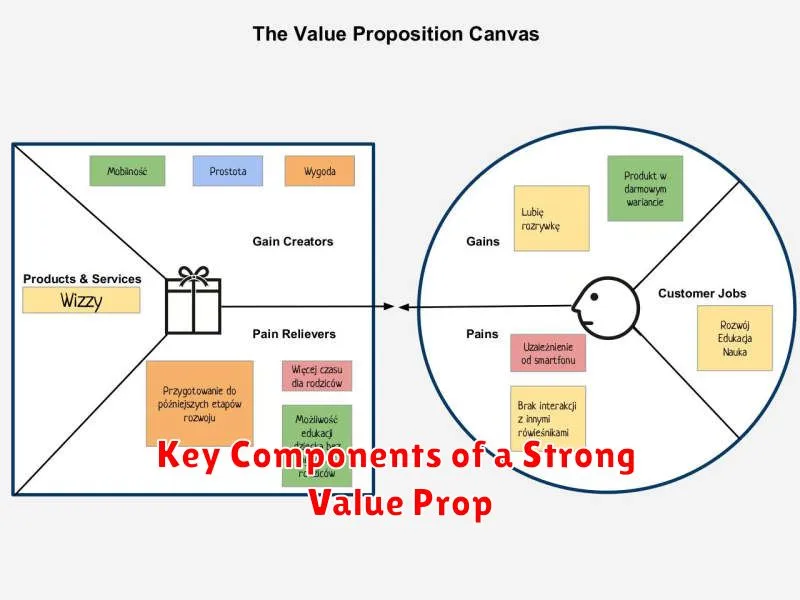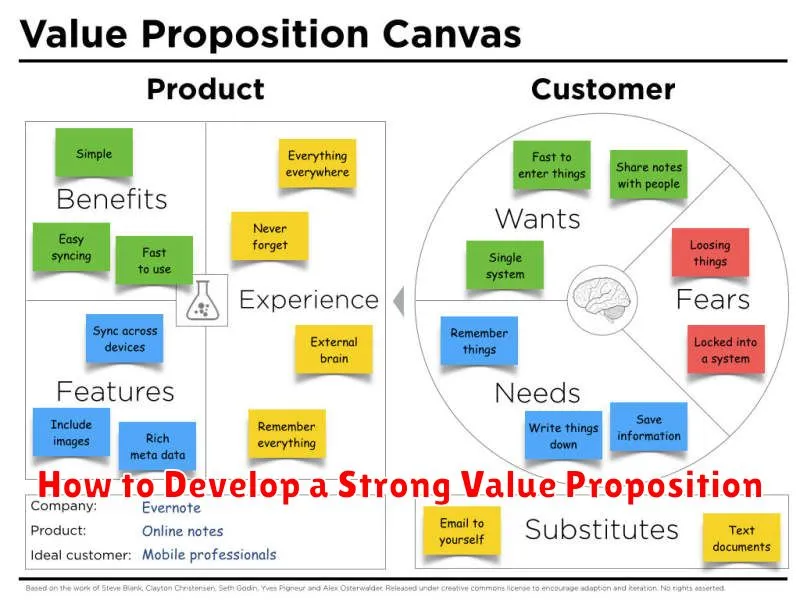Developing a strong value proposition is crucial for any business seeking to thrive in today’s competitive market. A well-defined value proposition clearly articulates the value your product or service provides to customers, differentiating you from the competition and driving customer engagement. This article will guide you through the process of crafting a compelling value proposition that resonates with your target audience and fuels business growth. Understanding the core components of a strong value proposition, including identifying your target customer, analyzing their needs, and highlighting your unique benefits, will be essential for success. By focusing on the value you deliver, you can effectively communicate why customers should choose you over alternative solutions.
Crafting a compelling value proposition requires a deep understanding of your target market and a thorough analysis of your competitive landscape. You must clearly define the specific problem your product or service solves and the tangible benefits it offers. By demonstrating a deep understanding of your customers’ pain points and presenting a clear solution, you can create a value proposition that resonates and persuades. This article will delve into the practical steps involved in developing a strong value proposition, from conducting market research and identifying key differentiators to crafting concise and impactful messaging. By mastering these techniques, you can position your business for sustainable growth and establish a lasting connection with your target customers.
What Is a Value Proposition?
A value proposition is a concise statement that clearly communicates the unique value your product or service offers to customers. It explains why a customer should choose your offering over competitors’ by highlighting the specific benefits they’ll receive and the problems you solve.
A strong value proposition isn’t just a slogan or a catchy tagline. It’s a carefully crafted statement that resonates with your target audience and persuades them that your offering is the best solution to their needs. It should be clear, compelling, and easily understandable.
Essentially, it answers the question: “Why should I buy from you?” It focuses on the tangible results customers can expect, emphasizing the value they’ll gain by choosing your product or service. This might include benefits like increased efficiency, cost savings, or improved performance.
A well-defined value proposition serves as the foundation for all your marketing and sales efforts. It provides a consistent message across all channels, ensuring that your target audience understands the key advantages of your offering.
Why It Matters for Marketing
A strong value proposition is crucial for effective marketing. It serves as the foundation upon which all marketing activities are built. Without a clear and compelling value proposition, marketing messages become diluted and fail to resonate with the target audience.
Differentiation is key in today’s competitive market. A strong value proposition clearly articulates what sets a product or service apart from the competition. It highlights the unique benefits customers receive and why they should choose one offering over another. This distinct value helps cut through the noise and attract customer attention.
Targeted Messaging becomes significantly easier with a well-defined value proposition. By understanding the core value offered, marketers can craft laser-focused messages that speak directly to the needs and desires of the target audience. This resonates more effectively and improves conversion rates.
A strong value proposition provides consistent messaging across all marketing channels. From website copy to social media posts, a clear value proposition ensures that the same core message is conveyed, reinforcing brand identity and building customer trust.
Key Components of a Strong Value Prop

A compelling value proposition clearly articulates the benefits a customer receives by choosing your product or service over the competition. Several key components contribute to its strength.
First, identify your target audience. Understanding their needs, pain points, and motivations is crucial. A value proposition targeted at the wrong audience will be ineffective.
Next, clearly define the problem your product or service solves. Focus on the specific challenges your target audience faces and how your offering provides a solution.
Highlight the key benefits of your product or service. These are the positive outcomes customers experience by using your offering. Focus on the value derived, not just the features.
Finally, articulate your unique selling proposition (USP). This is what differentiates you from the competition. It explains why customers should choose you over alternatives. A strong USP is essential for standing out in a crowded marketplace.
Identifying Customer Needs
Identifying customer needs is a crucial step in developing a strong value proposition. It involves understanding the challenges, desires, and unmet needs of your target customers. Thorough research is essential to gain these insights.
Methods for gathering information include customer surveys, interviews, and focus groups. Analyzing existing customer data, such as purchase history and support tickets, can also reveal valuable information about customer needs. Pay close attention to customer feedback and reviews, both positive and negative.
Look beyond the surface level of what customers say they want. Often, their expressed needs are symptoms of a deeper, underlying problem. By probing further, you can uncover the root causes of their challenges and identify opportunities to provide truly valuable solutions.
Consider the different segments within your target market. Different groups may have distinct needs and preferences. Segmenting your audience allows you to tailor your value proposition to resonate with each specific group.
Defining the Competitive Edge
A strong value proposition hinges on a clearly defined competitive edge. This refers to the unique advantages your product or service offers over existing alternatives in the market. It’s what sets you apart and makes you a more compelling choice for your target audience.
Identifying your competitive edge requires a thorough competitive analysis. This involves researching your competitors to understand their strengths, weaknesses, offerings, and target market. By comparing yourself to the competition, you can pinpoint areas where you excel or offer something different.
Your competitive edge could stem from various factors. It might be superior product quality, innovative features, a more affordable price, exceptional customer service, or a faster delivery time. It’s crucial to articulate this edge concisely and persuasively in your value proposition.
Once identified, your competitive advantage should be measurable and sustainable. A measurable edge allows you to track its effectiveness and demonstrate its impact. Sustainability ensures your advantage isn’t easily replicated by competitors, allowing you to maintain a strong market position over time.
Writing Clear and Persuasive Messaging
Crafting clear and persuasive messaging is crucial for a strong value proposition. Your message should directly address the needs and pain points of your target audience. Clearly articulate how your product or service offers a solution. Avoid jargon and technical terms that may confuse your audience. Focus on the benefits, not just the features.
Simplicity and conciseness are key. Use strong verbs and active voice. Keep sentences short and to the point. Focus on the core value you deliver and communicate it effectively. A clear message will resonate more strongly with your target audience and improve the effectiveness of your value proposition.
Consider using a structured format to present your message. For example:
- Headline: Briefly state the core benefit.
- Sub-headline: Expand on the headline and offer a more detailed explanation.
- Body: Provide further details and supporting evidence.
- Call to Action: Encourage the audience to take the next step.
Testing your messaging is essential. Gather feedback from your target audience to ensure your message is understood and resonates as intended. Refine your messaging based on the feedback received to optimize its impact.
Using Testimonials as Proof
Testimonials serve as compelling proof of your value proposition. They offer social proof, demonstrating that others have experienced the benefits you claim. Credibility is significantly enhanced when potential customers hear positive experiences directly from others.
Effective testimonials highlight specific results and quantify the impact your product or service has made. Instead of vague praise, focus on tangible outcomes. For example, a testimonial stating “This product increased our productivity by 15%” is far more impactful than “This product is great.” Quantifiable results provide concrete evidence of your value.
Choose testimonials that resonate with your target audience. If you’re targeting small businesses, a testimonial from a Fortune 500 company might not be as persuasive as one from a similar-sized business. Relevance is key to maximizing the impact of testimonials.
Finally, ensure the testimonials are authentic and from verifiable sources. Including the person’s name, title, and company adds to the credibility. Consider using video testimonials for even greater impact, as they offer a more personal and engaging connection with potential customers. Authenticity builds trust and strengthens the persuasive power of your testimonials.
Testing and Refining Messaging
Once you have developed a draft of your value proposition, the next crucial step is testing and refining its messaging. This involves gathering feedback from your target audience to understand how they perceive your value proposition and whether it resonates with their needs and motivations. Testing can take various forms, such as surveys, focus groups, A/B testing on landing pages, and interviews.
Pay close attention to how your audience reacts to your messaging. Do they understand the value you offer? Does it address their pain points? Does it differentiate you from the competition? Based on the feedback you receive, you may need to refine your messaging to make it clearer, more compelling, and more persuasive. This iterative process helps ensure your value proposition effectively communicates the unique benefits you provide.
Key metrics to track during testing include conversion rates, click-through rates, and customer feedback. Analyzing these metrics provides valuable insights into the effectiveness of your messaging and guides you in making data-driven adjustments.
Remember, testing and refining is not a one-time activity. As your business evolves and your target audience changes, you may need to revisit and update your value proposition to maintain its relevance and effectiveness. Continuous improvement ensures your messaging stays aligned with market demands and customer needs.
Aligning Value Prop Across Channels
Maintaining a consistent value proposition across all communication channels is crucial for building a strong brand identity and fostering customer trust. Consistency ensures that your target audience receives the same core message regardless of whether they interact with your brand through your website, social media platforms, email marketing, or in-person interactions.
Start by clearly defining your core value proposition. This concise statement should articulate the key benefits customers derive from choosing your product or service over competitors. Document this core message and use it as a reference point when creating content for different channels.
Tailor your messaging to each channel while retaining the essence of your core value proposition. While the core message remains constant, the format and tone may vary to suit the specific platform. For example, a concise, visually driven message might be more effective on Instagram, whereas a detailed explanation might be better suited for your website.
Regularly audit your channels to ensure consistent messaging. This process allows you to identify and rectify any discrepancies that may have emerged. Maintaining alignment reinforces brand recognition and prevents customer confusion, ultimately contributing to a stronger brand image and increased customer loyalty.
Examples from Leading Brands
Examining successful value propositions from established brands provides valuable insights. Apple, for example, positions itself beyond mere technology, focusing on design and user experience. Their concise messaging emphasizes simplicity and elegance, appealing to a consumer base that values these attributes. This focus is clear in slogans like “Think Different” and product names like “AirPods,” which convey a sense of lightness and effortlessness.
Tesla, another prime example, transcends being just an electric car manufacturer. They represent innovation and sustainability, appealing to environmentally conscious consumers while delivering high performance. Their value proposition revolves around accelerating the world’s transition to sustainable energy, extending beyond individual vehicles to encompass a broader mission.
Finally, Domino’s Pizza focuses on convenience and speed. While their core product remains pizza, their guarantee of swift delivery, coupled with digital ordering advancements, resonates strongly with busy customers seeking a quick and easy meal. This exemplifies how focusing on a key benefit, beyond the product itself, can differentiate a brand.

